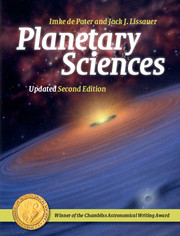Book contents
- Frontmatter
- Contents
- List of Tables
- Preface
- 1 Introduction
- 2 Dynamics
- 3 Solar Heating and Energy Transport
- 4 Planetary Atmospheres
- 5 Planetary Surfaces
- 6 Planetary Interiors
- 7 Magnetic Fields and Plasmas
- 8 Meteorites
- 9 Minor Planets
- 10 Comets
- 11 Planetary Rings
- 12 Extrasolar Planets
- 13 Planet Formation
- Appendix A List of Symbols Used
- Appendix B Acronyms Used
- Appendix C Units and Constants
- Appendix D Periodic Table of Elements
- Appendix E Observing Techniques
- Appendix F Interplanetary Spacecraft
- Appendix G Recent Developments in Planetary Sciences
- References
- Index
- Plate Section
- References
11 - Planetary Rings
Published online by Cambridge University Press: 05 January 2015
- Frontmatter
- Contents
- List of Tables
- Preface
- 1 Introduction
- 2 Dynamics
- 3 Solar Heating and Energy Transport
- 4 Planetary Atmospheres
- 5 Planetary Surfaces
- 6 Planetary Interiors
- 7 Magnetic Fields and Plasmas
- 8 Meteorites
- 9 Minor Planets
- 10 Comets
- 11 Planetary Rings
- 12 Extrasolar Planets
- 13 Planet Formation
- Appendix A List of Symbols Used
- Appendix B Acronyms Used
- Appendix C Units and Constants
- Appendix D Periodic Table of Elements
- Appendix E Observing Techniques
- Appendix F Interplanetary Spacecraft
- Appendix G Recent Developments in Planetary Sciences
- References
- Index
- Plate Section
- References
Summary
It (Saturn) is surrounded by a thin flat ring, nowhere touching, and inclined to the ecliptic.
Christiaan Huygens, published in Latin in anagram form in 1656Each of the four giant planets in our Solar System is surrounded by flat, annular features known as planetary rings. Planetary rings are composed of vast numbers of small satellites, which are unable to accrete into large moons because of their proximity to the planet.
When Galileo Galilei first observed Saturn's rings in 1610, he believed them to be two giant moons in orbit about the planet. However, these ‘moons’ appeared fixed in position, unlike the four satellites of Jupiter which he had previously observed. Moreover, Saturn's ‘moons’ had disappeared completely by the time Galileo resumed his observations of the planet in 1612. Many explanations were put forth to explain Saturn's ‘strange appendages’, which grew, shrank, and disappeared every 15 years (Fig. 11.1a). In 1656, Christiaan Huygens finally deduced the correct explanation, that Saturn's strange appendages are a flattened disk of material in Saturn's equatorial plane, which appear to vanish when the Earth passes through the plane of the disk (Fig. 11.1b).
For more than three centuries, Saturn was the only planet known to possess rings. Although Saturn's rings are quite broad, little structure within the ring system was detected from Earth (Fig. 11.2). Observational and theoretical progress towards understanding the physics of planetary rings was slow. But then, in March of 1977, an occultation of the star SAO 158687 revealed the narrow opaque rings of Uranus (Fig. 11.3) and launched a golden age of planetary ring exploration. The Voyager spacecraft first imaged and studied the broad but tenuous ring system of Jupiter in 1979 (§11.3.1). Pioneer 11 and the two Voyagers obtained close-up images of Saturn's spectacular ring system in 1979, 1980, and 1981 (Fig. 11.4; §11.3.2). Neptune's rings, whose most prominent features are azimuthally incomplete arcs, were discovered by stellar occultation in 1984. Voyager 2 obtained high-resolution images of the rings of Uranus in 1986 (§11.3.3) and the rings of Neptune in 1989 (§11.3.4).
- Type
- Chapter
- Information
- Planetary Sciences , pp. 448 - 488Publisher: Cambridge University PressPrint publication year: 2015



